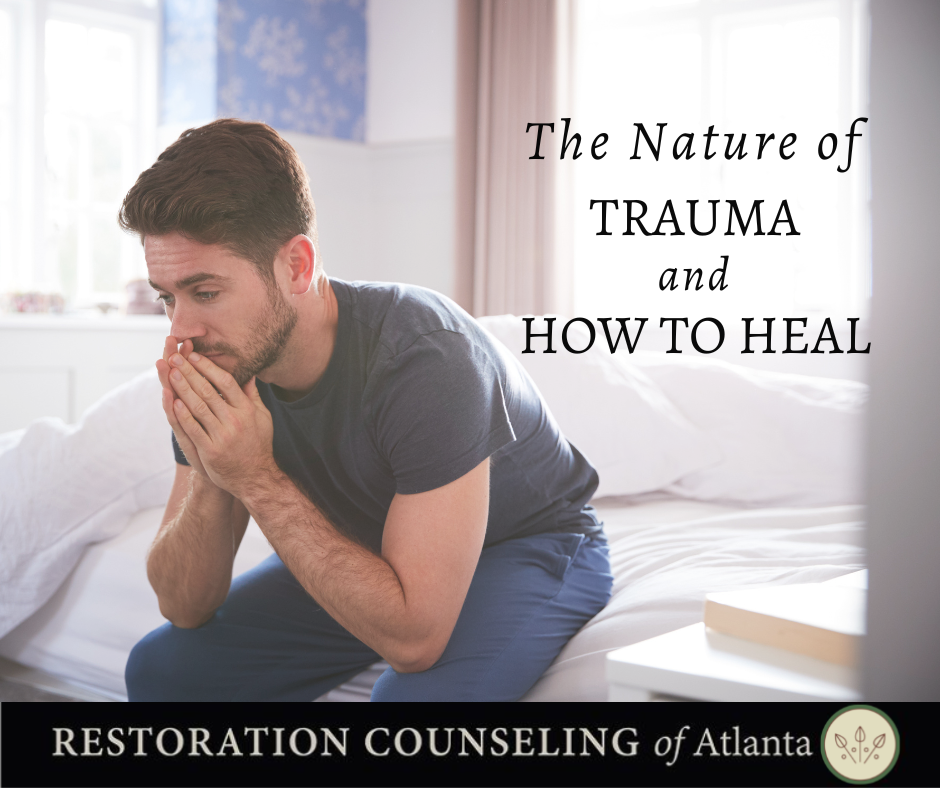What is the process of healing from trauma?
In this article, I will answer this frequently asked question and provide key coping strategies for healing from psychological trauma. Dr. Allender says, “we change at the level we are willing to enter reality.” Additionally, Dr. Thompson says, “[it] is not if we all are vulnerable but to what degree we enter into our vulnerability, especially of being hurt from the imperfections of being in a relationship.”
As discussed in Part 1 of this series, healing begins with understanding and acknowledging your story. As Dr. Bruce Perry stated in a conversation with Oprah, ‘it’s not what is wrong with you, but what happened to you.” Resolving trauma reclaims a secure attachment with yourself, God, and others as you heal individually and in broader relationships.
Healing from Trauma Individually
“The very same brain centers that interpret and feel physical pain also become activated during experiences of emotional rejection. In brain scans, they light up in response to social ostracism, just as they would when triggered by physically harmful stimuli. When people speak of feeling hurt or of having emotional pain, they are not being abstract or poetic, but scientifically quite precise.”
Healing is complex and often clouded by emotions, as our physical responses can be guided by previous trauma. Using modalities and techniques like EMDR, IFS, Somatic Experiencing, or trauma-informed experiential therapy, a trauma therapist can help validate and understand your trauma while restoring your ability to control your emotions and responses.
The Healing Process
1. Develop a relationship of trust with yourself.
The body is the container of our emotions, thoughts, brain, soul, and spirit. Since our emotions act as bodyguards who “take the hit” from trauma, it can be hard to put words to our memories or circumstances when dealing with the associated pain and shock. However, bringing curiosity to those emotions will enable us to develop and understand them more. Understanding them brings calmness, creativity, compassion, confidence, connection, clarity, curiosity, and courage to your life. [See my previous article on Internal Family Systems Therapy for additional explanation.]
2. Learn the role(s) of your emotions and how they may have been maladaptively shaped through trauma.
Your emotions adapt and cope when they are shaped by trauma. As such, moving toward your emotions and getting to know their hopes and fears can foster better understanding and self-acceptance. “Self-acceptance does not mean self-admiration or even self-liking at every moment of our lives, but tolerance for all our emotions, including those that make us feel uncomfortable.”
3. Return to the trauma memory and redo it.
The cure for the pain lies within the pain. To witness your trauma again is to reconnect with yourself and redo the experience in a redemptive and empowering way. Although immensely difficult, exercising your power and emotions in this much needed way will help to release the stronghold of the trauma.
4. Unburden your emotions.
Discover how the trauma altered your beliefs about yourself, God, others, and the world, and then release it. This can happen through rage, tears, truth, or visualization of placing the memory in the fire/water/earth/light or giving it to God. Above all, it needs to be released from the body.
5. Reclaim what was taken by the trauma.
Trauma can make you feel powerless, helpless, shameful, and weak. Unburdening your emotions creates space for them and for you to invite back what was lost, and enhance your attachments to yourself, your emotions, God, and others.
6. Allow for integration by reconnecting with your emotions and with your original purpose or what your younger self desired to do.
Give yourself space to heal from trauma by slowing life to a manageable pace. Practicing self-care like exercise, meditation, yoga, coping journals, or spending time with loved ones can meet your emotional needs. Additionally, in-person trauma support groups and an online trauma community are helpful, as are hobbies, volunteering, taking a masterclass, or other positive activities which give a feeling of accomplishment.
Overall, engage with the shame and emotions surrounding trauma in order to properly release it. Establish a tribe and be vulnerable with them through the healing process, for we are both hurt in relationships and healed in relationships.
In Part 3 of this series, I will discuss the dynamics of healing communally.
Supplemental Resources
IFS Workbook to Help with Healing
Written by: Micah Mabe, MA MFT, APC
Roswell Location
micah@restorationcounselingatl.com, ext. 158
Micah offers services in-person at the Roswell office and virtually and can provide EMDR through an online platform. He enjoys working with individuals, couples, and families in various areas, including emotional dysregulation, anger management, anxiety, depression, life transitions, grief, pornography and sexual struggles, trauma, dissociation, relational disconnection, and more. He uses various approaches to counseling, such as EMDR, Experiential therapy, IFS, Narrative therapy, and EFT, to help clients find understanding, attunement, skills, and healing within themselves and with others.
[1] Allender, D. B., & Loerzel, C. (2021). Redeeming heartache: How past suffering reveals our true calling (pg. 162). Zondervan.
[2] Thompson, C. (2021). The Soul of shame: Retelling the stories we believe about ourselves . READHOWYOUWANT.
[3] Perry, B. D., & Winfrey, O. (2021). What happened to you?: Conversations on trauma, resilience, and healing. Flatiron.
[4] Eisenberger, N. I. (2012). The neural bases of Social Pain. Psychosomatic Medicine, 74(2), 126–135. https://doi.org/10.1097/psy.0b013e3182464dd1
[5] Pastor, M., & Gauvain, J. (2020). Internal Family Systems Institute: Level 1 Training Manual (pgs. 85-86). Oak Park: IL. Trailhead Publications.
[6] Mate, G. (2014). Scattered: How attention deficit disorder originates and what you can do about it (pg. 274). Plume.


